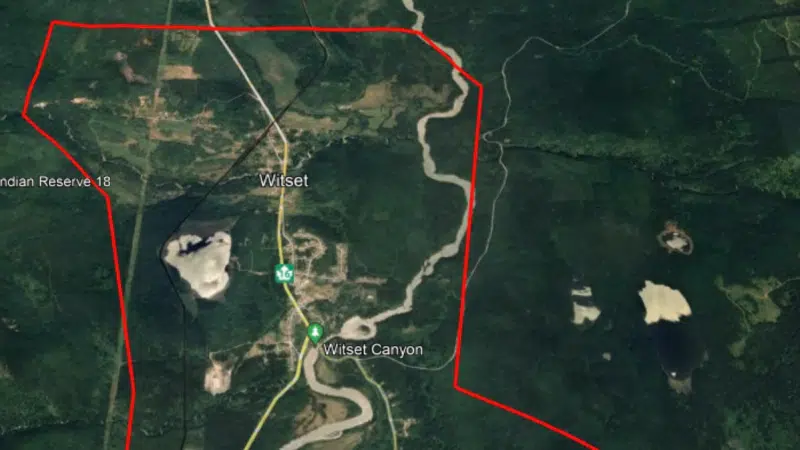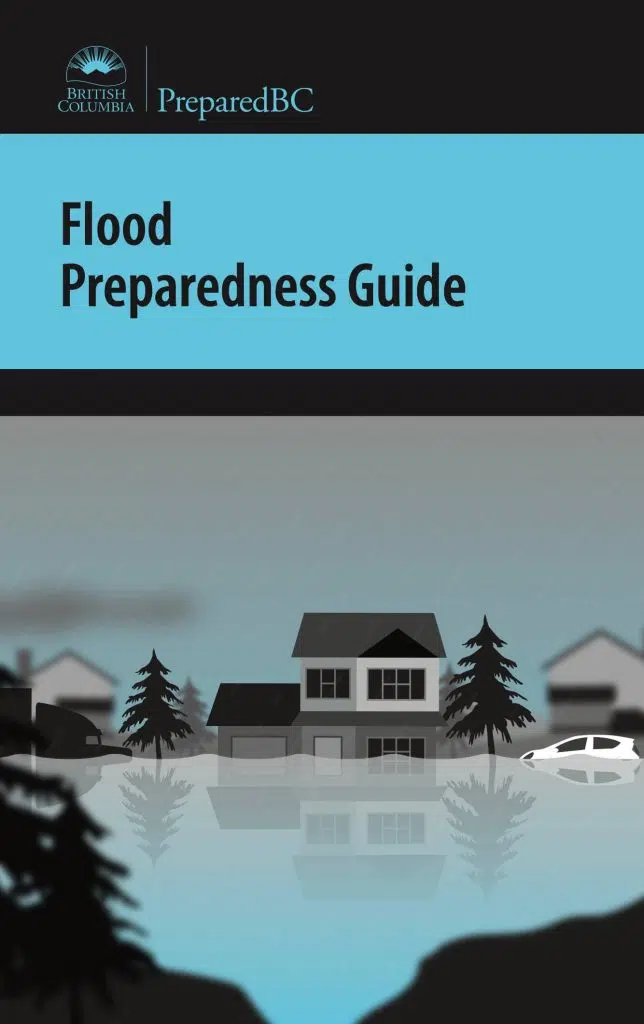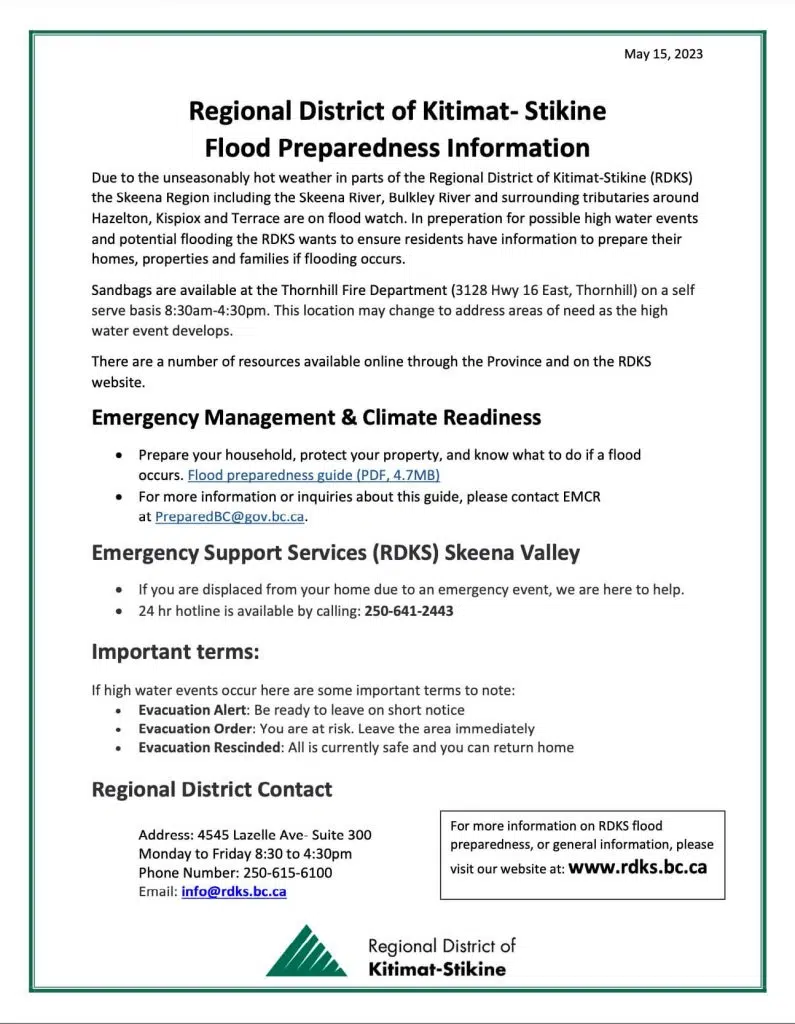Emergency Alerts & Advisories for Northern BC
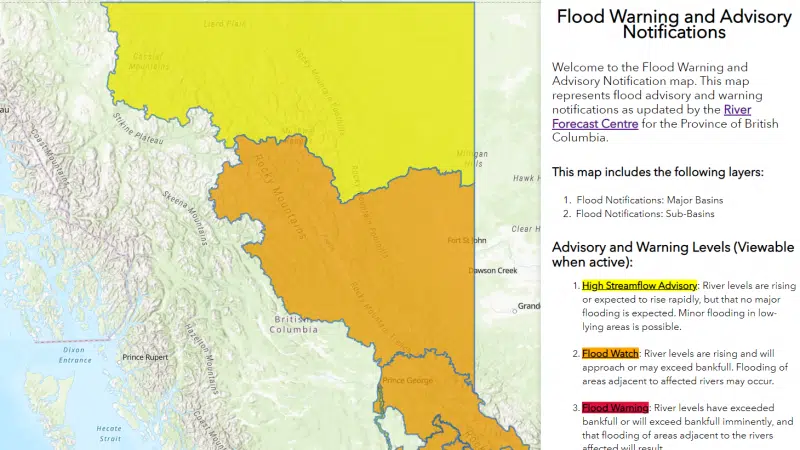
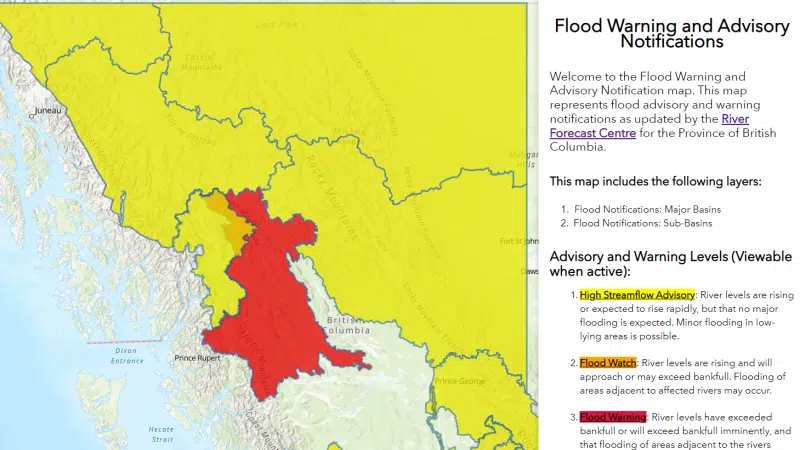
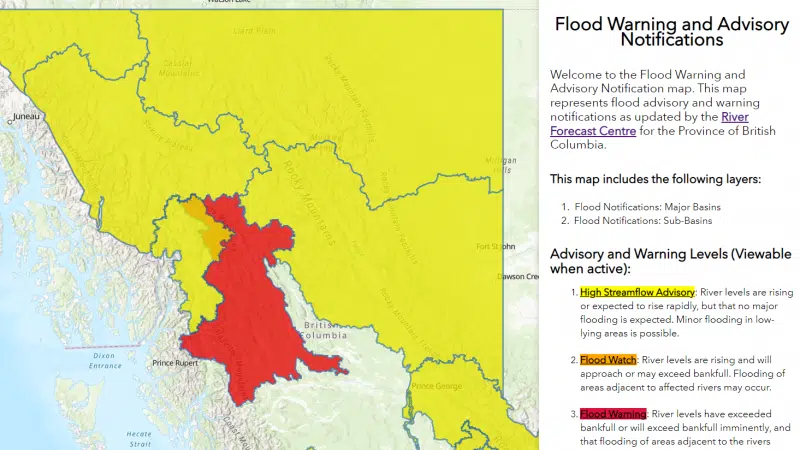
In light of what appears to be a long term global shift of the weather patters to the extreme that has and will continue to negatively affect our lives here in Northern and central BC, it can’t be emphasized enough for everyone to be properly prepared for emergencies.
In the event of an emergency such as wildfire, tsunami, earthquake, flooding, CFNR Network is there for you. CFNR commits all of its resources and has the capability to get communications out 24/7 to its listeners with the latest information and updates on the situation and any orders that are in effect. CFNR will work with your local emergency services providers to relay messages on evacuations, marshaling areas, and when it’s safe to return as we receive them to ensure you and your family’s safety. To be set up with CFNR’s emergency messaging system, Emergency Services Coordinators, please call 1-866-833-2367
Emergency Preparedness
Be prepared for at least 72 Hours
Here are some helpful tips:
Get prepared for floods
Translated content: Français (French) | 简体中文 (Simplified Chinese) | 繁體中文 (Traditional Chinese) | ਪੰਜਾਬੀ (Punjabi)
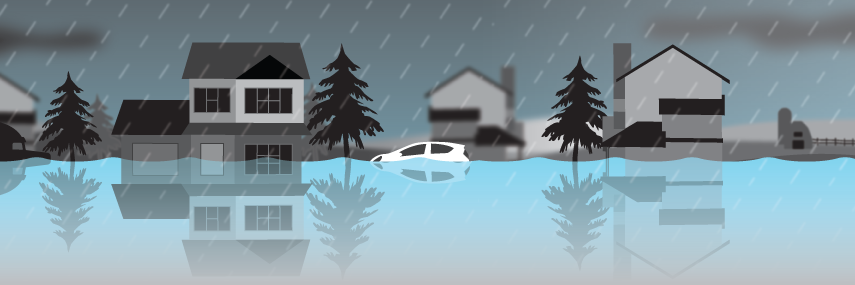
Floods are common in B.C. and can happen at any time of year. The most severe floods usually occur in spring and early summer due to heavy rain and melting snow. This seasonal flooding is known as freshet.
Floods can damage buildings, cause power outages, disrupt transportation, create landslides and be a hazard for people.
Climate change and flooding
Our climate is changing. Annual precipitation has increased across the province, and summers tend to be drier than in the past. These trends contribute to increasingly destructive weather events, including flooding. Read about how B.C. is preparing for and adapting to climate change.
Stages of a flood
Depending on the type and severity of flooding, it could take weeks or months for the water to recede. It’s important to take time to prepare and understand what to do before, during and after a major flood:
Get prepared
If you’re in an area that is prone to flooding, or you just want to be proactive, there are a number of activities you can complete to prepare for a flood.
Stay safe
You can stay safe during a flood by understanding flood advisories and warnings, evacuation stages, and actions you can take to protect yourself.
Recover
Returning home after a flood can be overwhelming, but if you use caution and take things one step at a time, it is possible to recover and return your home to normal.
Social media resources
To help prepare and respond to seasonal flooding, we have created an easy-to-use social media package with graphics and pre-written content.
Flood preparedness guide
Prepare your household, protect your property and know what to do if a flood occurs.
For more information or inquiries about this guide, please contact us at PreparedBC@gov.bc.ca.
EARTHQUAKES
BEFORE, DURING, AND AFTER
Earthquakes are common in BC and more than 1,200 are recorded each year across the province.
The coast of BC is considered to be a high-risk earthquake zone. In this region, tectonic plates are moving apart, sliding past one another and colliding. It is the movement of these plates that causes small earthquakes (daily), potentially damaging earthquakes (decades apart), and some of the world’s largest earthquakes (centuries apart).
Earthquakes strike without warning, so it is important to act now to get prepared.
Before the Shaking Starts
Prepare Your Family
- Know the safe spots in each room- against inside walls, under sturdy tables, desks or archways.
- Know the danger spots- windows, mirrors, hanging objects, fireplaces and tall, unsecured furniture.
- Practice Family drills. Physically place yourself in safe locations. This is especially important for children.
- Learn first aid and CPR.
- Keep a listing of emergency numbers.
- Prepare a family emergency kit with supplies for at least 72 hours.
Prepare Your Home
- Learn how to shut of gas, water and electricity.
- Keep breakables or heavy objects on bottom shelves.
- Secure tall heavy furniture which could topple, such as bookcases, china cabinets or wall units.
- Secure the water heater and appliances.
- Secure hanging plants and heavy picture frames or mirrors (especially over beds).
- Put latches on cabinet doors to hold closed during shaking.
- Keep flammable or hazardous liquids such as paints, pest sprays or cleaning products in the garage or outside shed.
- Check chimneys, roofs, walls foundations for structural condition.
- Maintain emergency food, water and other supplies, including flashlight, a portable battery-operated radio, extra batteries, medicines, first aid kit and clothing.
During the Shaking
- If indoors, stay there. Drop, cover and hold. Get under a desk or table and hang on. Alternately, you can stand in an archway or corner.
- If outdoors, get into an open area away from trees, buildings, walls and power lines.
- If in a high-rise building, stay away from windows and outside walls. Get under a table. Do not use elevators.
- If driving, pull your car to the side of the road and stop. Avoid overpasses or power lines. Remain inside until the shaking is over.
- If in a crowded public place, do not rush for the doors. Move away from display shelves containing objects that may fall.
- In all instances, drop, cover and hold; protect your head as much as possible.
After the Shaking Stops
- Stay calm and check for injuries. Apply first aid if qualified. Do not move any seriously injured individuals unless they are in immediate danger.
- Check for fires, gas and water leaks and damaged electrical wiring or sewer lines.
- If you smell gas, do not use matches, candles, etc. And do not operate electrical switches.
- Check building for cracks and damage, including roof, chimneys and foundation. If you suspect there is serious damage, turn off all utilities and leave the building.
- Check food and water supplies. Emergency water may be obtained from water heaters, melted ice cubes, toilet tanks and canned vegetables.
- Seek sources of uncontaminated water. In an emergency, purify water by straining through a paper towel or several layers of clean cloth and by boiling vigorously for at least six minutes.
- Do not use BBQ’s, camp stoves or unvented heaters indoors.
- Do not flush toilet if sewer line is damaged.
- Do not use the telephone unless there is a severe injury or fire to report.
- Turn on your portable radio for instructions and news reports, and cooperate fully with public safety officials.
- Keep Disaster Response Routes clear for emergency vehicles.
- Be prepared for aftershocks.
Movement of the ground is seldom the actual cause of death or injury. Most casualties result from partial building collapse, falling objects and debris, like toppling chimneys, ceiling plaster and light fixtures.
Remember-
Stay calm and lend a hand to others in need.
TSUNAMI INFORMATION
What is a tsunami?
A tsunami is a series of ocean waves which are sometimes generated at the same time as an earthquake far away in the Pacific Ocean, it may take hours for waves to reach coastal British Columbia, and there is a Tsunami Warning and Alerting Plan in place to pass the warning to coastal residents as quickly as possible.
Tsunamis are not “tidal waves”. They have nothing to do with tides, or weather, and they act quite differently from ordinary waves. They can move through the open ocean at hundreds of kilometres an hour and be scarcely noticed, even when they pass under a boat. But, when they reach shallower water near shore, they become a very powerful surge of water or even huge breaking waves. The first wave of tsunami is not the largest. Other waves may follow every few minutes, for a period of hours.
The force of tsunami waves can cause great destruction in harbours and the height of tsunami waves increases as they run into rivers and coastal channels.
TSUNAMI PREPAREDNESS
If you are near the coast and feel intensely strong shaking from an earthquake- strong enough to make standing difficult- it is best advised to head to high ground immediately (greater than 10 metres or 30 feet above the tide line).
Local emergency officials may not have enough time to issue a warning to residents in the event of tsunami created by a near-shore earthquake. It is important to remember that tsunamis are rare events, and not all earthquakes will generate a tsunami. However it is also critical to know what to do as a precaution if you live a vulnerable area. For more information on tsunamis preparedness contact your local emergency program coordinator or visit the Provincial Emergency Program website at: www. pep.bc.ca
Rare But Serious….
If a Tsunami Watch or Warning is issued for your area, listen to your local media and follow the instructions of local emergency officials. Tsunami Watch- be alert and get prepared for further instructions by local officials. Tsunami Warning- local officials may be starting to evacuate high-risk areas along pre- determined evacuation routes. Give local emergency officials your fullest cooperation. More information about watch or warning status and a detailed notification zone map for risk areas is available here tsunami_zone_province_final In the Event of an Immediate Tsunami Threat Move to higher ground.
- If you are in a coastal area identified in a tsunami risk zone, and you feel intense shaking from a near-shore earthquake, it is advisable to move immediately to higher ground (great than 10 metres or 30 feet above the tide line)
- Some communities have pre-identified safe areas that you should be aware of. Stay tuned to your radio for updates.
Follow the instructions of all emergency officials. This is for your safety and the safety of those around you.
In the first 24 hours, use the telephone only to report life-threatening emergencies.
Do not go to the beach to watch. All areas of the coastline will not be impacted equally. Within very short distances, the effects of a tsunami may vary considerably and there could be dramatic differences in wave height and impact. Protect Yourself, Your Family and Your Property
- Know where you and your family will evacuate to in the event of a tsunami.
- Know how you will get to your pre-determined safe area.
- Maintain a family emergency kit in state of readiness for unexpected evacuation.
- Listen to local media and follow the instructions of emergency officials.
Build an Emergency Kit (www2.gov.bc.ca)
Creating a home emergency kit doesn’t need to take long. Just follow the basic list below. In addition, remember to add personal items, such as prescription medications, an extra pair of eyeglasses and copies of important documents like passports, birth certificates and insurance papers.
Always make sure emergency kits are in easily accessible locations.
The Importance of Water
How much is enough?
The general rule is four litres of water per person per day, but there are a few caveats:
- Children, nursing mothers and sick people may need more
- If you live in a warm region of B.C., hot temperatures can double water needs
- Pets need about 30 millilitres of water per kilogram of body weight per day. For example, an average-sized cat or small-sized dog needs at least 1/5 of a litre, or half a cup, daily
How and where do I store my water?
It’s recommended you purchase commercially-bottled water and keep it in its original container in an easily accessible, cool and dark place. Don’t open it until you need it.
Observe the expiration or “best before” dates. Set a reminder in your phone or remember to check the dates when the clocks “spring forward” and “fall back”.
What hidden water sources are available in my home?
It’s easy to locate safe water sources in your home. These include the water in your hot-water tank, pipes and ice cubes. It’s recommended you don’t use water from toilet tanks or bowls, radiators, waterbeds, swimming pools or spas.
Can I purify my own water?
We recommend purchasing commercially-bottled water; however, the Ministry of Health has information on the steps you can take to purify and bottle your own.
What about water filtration devices?
These devices are becoming more and more popular, perhaps because they don’t take up as much room as several litres of bottled water. There are a lot of different options out there – different brands offer many different types, ranging from water bottle-sized to 18-litre containers or larger. If you choose to go this route, it’s still not a bad idea to store some bottled water as well.
Grab-and-go
Don’t count on being home when there’s an emergency. In addition to having one at home, create grab-and-go bags for your work and vehicles that contain:
- Food (ready to eat) and water
- Flashlight and batteries
- AM/FM radio
- Medications
- Seasonal clothing
- Blanket
- Cell phone charger
- Pen and notepad
- Personal toiletries
- Small First-Aid kit
- Extra pair of glasses or contacts
- Cash in small bills
- Local map with your family meeting place identified
- Whistle



